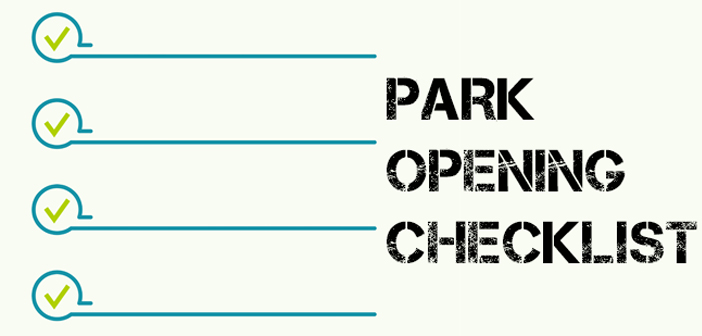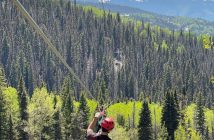Opening your park for the day involves a team of staff accomplishing a variety of tasks—often simultaneously. While the specific policies and procedures will vary from course to course, there are a few core practices and considerations that should be a part of every organization’s daily to-do list before patrons arrive. For simplicity sake, let’s divvy up the process into three parts: administrative and logistical tasks, operational equipment, and the physical course.
Administrative and Logistical Tasks
This part includes things most businesses need to consider when opening for the day, plus a few industry-specific items as well. There are inward facing or behind-the-scenes tasks, such as checking the reservation system, preparing waivers, charging radios and cameras, and verifying that payment processing systems are operational. Do you use vehicles to access the course? If so, they need to be clean, fueled, and functioning.
Tasks for outward-facing aspects of daily operations address items that are highly visible to patrons. These include ensuring your check-in area, the grounds, and bathrooms are clean and orderly. Check that merchandise and refreshments are stocked and organized. Some standards (and good manners) require that basic amenities be provided for all guests, such as access to drinking water and hand washing stations. Take the time to make sure that all of the systems you depend on are functional and your guests will be comfortable.
Operational Equipment
Most equipment manufacturers—and industry standards—require all operational equipment used on your course to be inspected prior to each use. The staff tasked with inspecting operational equipment must be specifically trained to do so, and they must follow manufacturer’s inspection procedures and retirement criteria.
All of the helmets, harnesses, tethers, pulleys, ropes, and other related equipment that will be used should be individually assessed every day. Include all staff/operator equipment and rescue gear with morning inspections. Keep in mind that any operational equipment located permanently on the course must be assessed during your daily inspections, including specialty equipment like auto belays and braking systems.
Any equipment that is in poor or questionable condition needs to be removed from service, marked, and either repaired or replaced. When you’ve completed your inspections, document everything and begin laying out equipment for use.
The Physical Course
The daily course inspection is a critical part of your opening rituals. The specific procedures for each course will vary based on design, manufacturer, environment, throughput, wear-and-tear, standards, and local regulations. However, there are a few general guidelines to consider for every course:
- use a written checklist for prior-to-use inspections
- assess the course for both risk and function
- take action to resolve critical issues
- provide for the safety of your course inspectors
- document everything.
The employees responsible for completing the daily inspections must be appropriately trained to do so, and afforded the personal protective equipment and tools that enable them to complete their work safely and effectively. Often, standard operational equipment is sufficient, but if your staff is required to climb in order to access components of the course, they may require an alternate belay system, or even specialized equipment. Solving access issues may be as simple as using a ladder.
On the other hand, if staff must climb above an anchor and are exposed to a potential free-fall of six feet or greater, OSHA requires that staff member to wear a full body harness with rear dorsal connection and a shock absorbing device. When in doubt, if staff are required to access anything “off route” or beyond standard operational components of the course, consult your course installer/manufacturer or another Qualified Person to see what training and equipment may be required.
Assuming this is all properly addressed, the trained staff should begin with a visual assessment of the course and surrounding environment. Look for signs of unauthorized use, structural or storm damage, or any other concerns prior to entering the course. Are there fallen trees or branches on or around the course? Are towers and support structures appropriately vertical and free of defects? Check all guy cables and ground anchors for any signs of change. At any point during the inspection process, if safety of the inspector is a concern, do not continue—and close all or portions of the course as needed until such issues are resolved.
If there are no red flags from the ground assessment, proceed to a visual and tactile inspection of the structures, belays, and obstacles at height. Assess the trees, towers, decks, stairs, and ladders, as well as belay cables, zip lines, and anchors for signs of damage, stress, or change from installed condition. Follow manufacturer recommendations for assessing these items, and use additional tools or resources as needed or directed (such as torque wrench or binoculars). As you move through the course, identify hazards, functional issues, and even cosmetic defects. In some situations you may be required to complete a full function test of all elements prior to opening for the day.
Document the findings of the inspection, including who inspected it, when it was inspected, a description of the present condition, and—the most critical step—assign actions to the findings and follow through. Are repairs required for safety or function prior to use? If so, close access to the affected components or course until it is repaired and documented. Are there minor defects or cosmetic issues that do not present a hazard, but should be addressed? Write them down and take care of them at your earliest opportunity. Overall, when in doubt, get a professional opinion before putting guests on anything in question.
End of Day Procedure
At the end of the day, think about what you can do today to prepare for an easier tomorrow. Use this time to clean up, stock merchandise, and fuel vehicles—leaving your mornings to simply verify it has been done and move on to more pressing matters. Set radios and cameras up to charge overnight, and update your reservations and staff schedule for the next day. Verify that all of your records from the day’s events are in order, including inspection records, equipment logs, waivers, and incident reports. Address, or confirm plans to address, any maintenance items.
Out on the course, remove ladders, lock gates, and engage all the access prevention devices to ward off trespassers. Bring in any equipment that must be stored indoors. Make walking the grounds and facilities a part of your end-of-day ritual, ensuring everything is clean and secure.
It can be a bit daunting to ensure everything that needs to happen every day indeed happens. Don’t be afraid to ask for help from a professional when you need it, and don’t make it harder than it needs to be.
Here’s the short and sweet summary: write it down, do it, and then write down that you did it. And don’t forget to flip the “open” sign.
For your reference, here’s a helpful checklist:
Admin / Logistics
- Turn on and test check-in & payment processing systems
- Check phone messages, emails, and new registrations
- Check weather reports
- Confirm staff schedule (Do you need more or less staff based on number of participants?)
- Prepare waivers and guest paperwork
- Confirm office, storefront, bathrooms, and grounds are clean
- Vehicles are fueled, clean, and functioning (where are the keys?!)
- Cameras/photo system is charged and functioning
- Radios are charged and functioning
- Guest amenities are stocked
- Merchandise is stocked
- Displays are set up and running (such as slideshows or videos)
- Staff is ready (is everyone present, clear-headed, clean, and professional?)
Equipment
- Guest equipment is inspected and ready for use
- Operator equipment is inspected and ready for use
- Rescue equipment is inspected, ready for use, and located as needed on or off course
- Comply with manufacturer’s’ recommendations for prior-to-use inspection of specialty equipment (auto-belays, braking systems, auto-descenders)
- On-course equipment is inspected and ready to use
- Failed/questionable equipment is marked and quarantined/repaired as needed
- Inspection documentation is complete and on file (who did it, what was inspected, condition, problems, and resolutions)
Course
- Remove access limitation devices, extend ladders, and unlock gates where required
- Visual assessment of the course and environment from the ground
- Visual and tactile inspection of critical systems at height
- Functional assessment of routes, rides, and elements
- All failed/questionable course components are marked and closed/repaired as needed
- Inspection documentation is complete and on file (who did it, what was inspected, condition, problems, and resolutions)
Closing Procedures
- Complete and document daily maintenance or action items for both the course and equipment (includes cleaning and properly storing guest and operator equipment)
- Engage access limitation devices, retract/remove ladders, and lock gates where required
- Clean bathrooms, office space, vehicles, and grounds
- Refuel vehicles and charge radios, cameras, and other portable electronics
- Restock merchandise and refreshments
- Operational and rescue equipment is securely stored, in clean and dry condition
- Verify daily inspection, participation, and incident records are complete
- Confirm reservations and staffing for the next day






